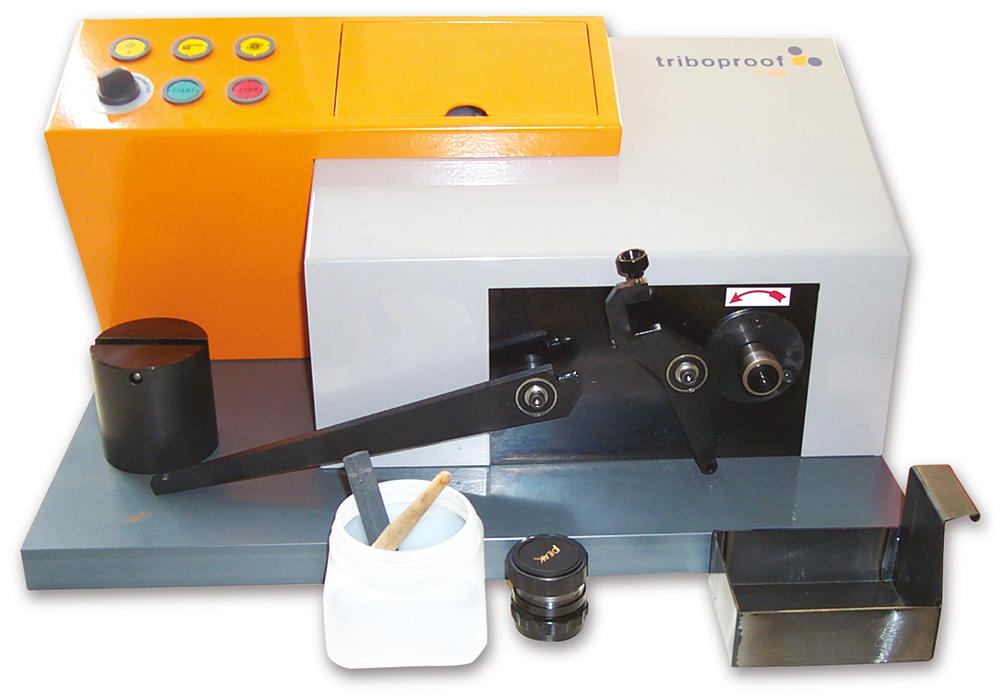Brugger test - load capacity of lubricants
Year of publication: 2003
Updated on: 09-2023
The minimum requirements for hydraulic and gear oils are firmly defined in DIN standards. However, they do not guarantee the trouble-free operation of certain equipment in all cases. This applies particularly to slow-running gearboxes subject to shock loads, vane pumps, threaded couplings, bed ways and steel/bronze pairings in plain bearings. Often the load capacity of the oil used is not sufficient. To clearly analyse the load capacity of the lubricant, the practical Brugger test was developed. A lubricant tester according to Brugger is installed in the OELCHECK laboratory.
For hydraulic and gear oils in industrial use, the following minimum requirements have been defined so far. They relate to wear protection and scuffing behaviour.
Table of contents
Hydraulic oil HLP
- Standard: DIN 51524/2
- Previous test procedures: FZG test, damage force level at least 10, and the vane pump test with a ring wear of maximum 120 mg and a vane wear of maximum 30 mg.
Gear oil CLP
- Standard: DIN 51517/3
- Previous test procedures: FZG test, damage force level at least 12 and a wear value of maximum 0.3 mg/kWh.
Expressiveness and reliability
The test procedure according to Brugger provides a decision-making basis for a correct lubricant selection regarding to the lubricant load capacity. A large number of measurements have shown that the reproducibility of the results is good. Scatter lies at ± 10 % of the measured values.
An example from practice
- AUDI AG monitors large presses with the Brugger test (OelChecker Summer 2003)
When this articles was first published, seven presses from the manufacturers Müller Weingarten, Schuler and Erfurt were in use in the press plant in Ingolstadt. The largest press, which was filled with approx. 10,000 litres of hydraulic oil, produced up to 10,000 parts in 24 hours. The hydraulic oils used were of the types HLP and HLP-D 46 and for gears, mainly oils of the ISO-VG classes 150 or 220 were used. Gears in large presses are unconventional machine elements because of the low rotation frequency, compact design and high, shock-like load. The bearing points are exposed to increased thermal stress. The plant manufacturers prescribe the Brugger test in addition to the regular lubricant analyses. In the case of the presses at the Audi plant, it was regularly carried out once a year. This reliably tested the oil for its load capacity. At Audi, the Brugger test has already paid off: by detecting wear on a bearing bush in good time, major damage was prevented. While an unscheduled shutdown would have cost several hundred thousand euros, the early intervention of the responsible production manager allowed the repair to be planned and optimally fitted into the ongoing production process.
The capacity of the Brugger Test - an inventory
Pro
It supports statements about additive changes in the used oil analysis, because it shows the load capacity and the adhesion of a lubricant in mixed friction, which occurs preferentially with:
-
All stops and restarts of machines or engines
-
Reversing movements such as up and down, back and forth
-
Vibrations and stop loads
-
Low sliding speeds
This is demonstrated in practice by:
-
Slipping and chattering on hydraulic cylinders (slip-stick)
-
Hydraulic pumps, especially vane pumps, with weakened delivery capacity
-
Stuttering movements of tool slides over the bed tracks
-
Wear of threaded couplings and adjusting spindles
-
Pitting of teeth in slow-running gearboxes
-
Abrasion due to insufficiently wetted steel/bronze pairings, e.g. in plain bearings
Contra
The test run is not suitable as a single test for a lubricant assessment instead of a complete analysis because:
-
no single parameter alone can reflect the diversity and complexity of lubricant requirements in practice
-
the short test time cannot provide equally meaningful results for all wear mechanisms
-
the transferability of the test results to materials other than the steel materials used for testing must be examined
Hardly any statements can be made about...
-
...the expected running time of a gearbox, bearing or other machine element
-
...contamination, mixing or viscosity changes in the lubricant
-
...the oil service life or oxidation stability





